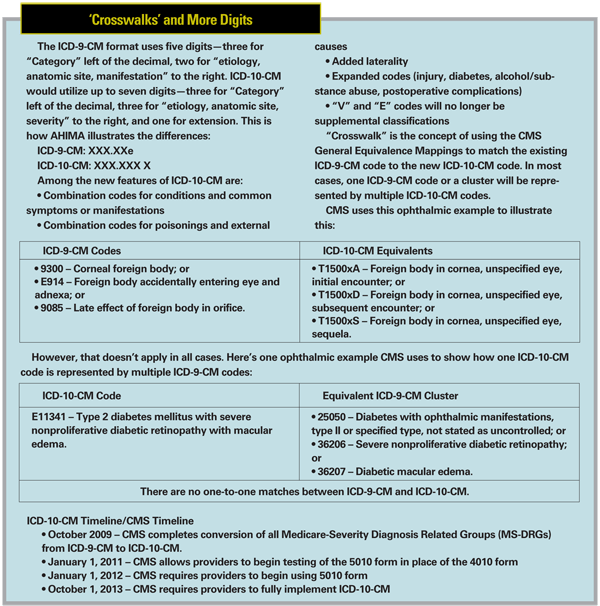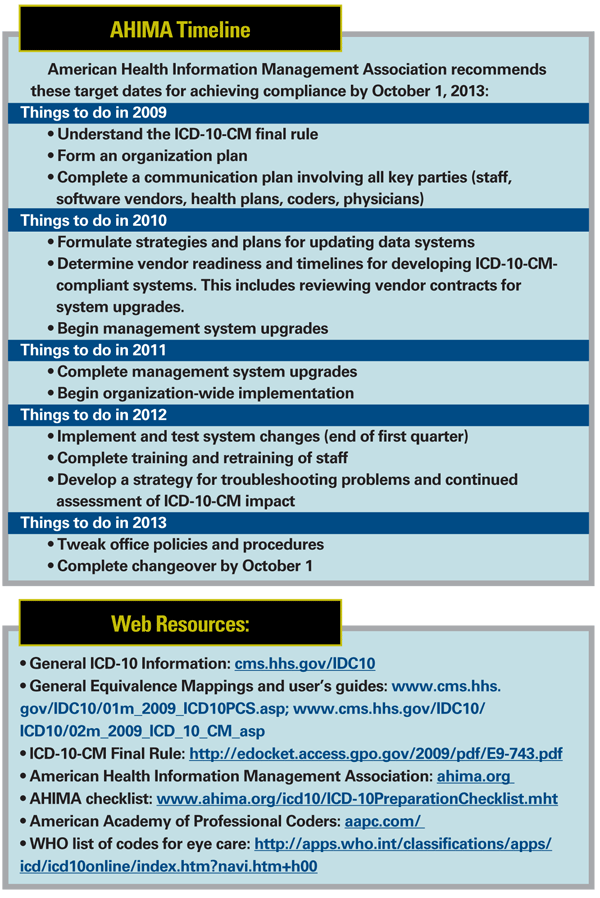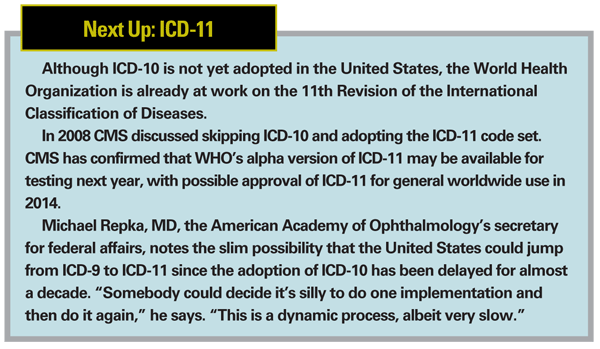Like just about all ophthalmologists, Michael Repka, MD, can rattle off the ICD-9-CM code for posterior subcapsular cataract, 366.14, without pausing to think. He knows in a few years it won't be so easy. He'll have to learn an entirely new code set as the
There is more to that changeover than learning new codes (the ICD-10 code for posterior subcapsular will be H25.04). "The payers are going to require laterality," Dr. Repka says.
"That's where you have to add the .041 for the right eye, .042 for the left eye, .043 for bilateral and .049 if you don't specify."
Laterality is one of the words those schooled in the vernacular of ICD-10-CM use a lot. Specificity, granularity and crosswalks are others you'll be hearing as ICD-10-CM invades your world. A crosswalk is a match of the existing ICD-9-CM code to the more specific ICD-10-CM code. Unspecified codes, frequently used in ICD-9-CM, will be a rarity in ICD-10-CM.
For physicians, ICD-10-CM contains more diagnosis codes—68,069 compared with 14,025 in ICD-9-CM. The changeover, due to take effect October 1, 2013, will also cost the typical physician about $28,000 in lost productivity, dropped claims, staff training and software. This paradigm shift may be years away, but is sure to hit. Section 4 of your insurance policy against the medical tsunami focuses on preparing your practice for ICD-10.
Why ICD-10? Why Now?
ICD stands for International Classification of Diseases. Ten years ago the Centers for Medicare & Medicaid Services adopted ICD-9 for diagnosis codes. The World Health Organization developed ICD-10 (the 10 is for 10th Revision) because the previous revision was running out of space for new codes. Other reasons WHO gives for scrapping the ninth revision were obsolete terminology and classifications for some conditions, inability to keep pace with advancing medical technology and lack of international comparability. ICD-10-CM would also bring the
CMS adopted ICD-10 with two wrinkles: ICD-10-CM (for clinical modification), the diagnostic coding system physicians must use; and ICD-10-PCS (for procedural coding system) for hospital settings. For procedures, physician offices and outpatient facilities will continue to use CPT.
The
"But much of the push frankly was on the ICD-10-PCS side from the hospitals," he says. "They were arguing that they had had all these new procedures and equipment, and there were no codes for them. They felt they weren't getting the reimbursement that they deserve." Medical device manufacturers also joined the push. On the practitioner side, CMS felt the greater specificity of ICD-10-CM codes would also curb fraud and abuse. "So we're stuck with this," Mr. Tennant adds.

What It's Going to Cost
That also means getting stuck with the bill for transitioning to the new code set. Again citing
Consultant Stanley Nachimson did a study for the MGMA and nine other provider organizations, showing the changeover will cost a small practice of three physicians around $83,000. The larger the practice, the steeper the price: $285,000 for a 10-doctor office, and about $2.7 million for a practice of 100 practitioners. Before starting his own consulting business, Mr. Nachimson worked at CMS on the team charged with calculating costs for the ICD-10 changeover.
However, Mr. Nachimson's estimates do not include the costs for implementing or upgrading electronic medical record systems eligible for bonus payments under the federal economic stimulus plan approved earlier this year (see "Washington Moves EMR Off the Back Burner," June 2009). He explains it does include costs for retooling EMRs to handle the more voluminous ICD-10-CM code sets. He offers one example: "The superbill would have to be either expanded to five pages or automated in some way."
"During the first year there are going to be some payment delays and perhaps rejections as both health plans and providers get used to the new codes, new coverage guidelines and things like that," Mr. Nachimson says. "The delay in payment also has an impact on any practice, and we conservatively estimate it at about 1 percent impact on cash flow."
Challenging the System
ICD-10-CM uses more decimal places than ICD-9-CM, and that poses a major changeover for practice management systems. "The billing systems are what's going to be impacted because our current systems have three-digit decimal points, and now we're going to a longer system that has seven digits," says coding consultant Lisa Campbell, PhD, chief executive officer of Physician Practice Resources Inc. in

Using ICD-10-CM will also involve adopting the new HIPAA claim form: the 5010 version of the -837. The
"The reality is that ophthalmologists will have to work with their vendors to make the necessary changes to the systems to accommodate both the 5010 [claim form] changes and ICD-10-CM," Mr. Tennant says. The "new wrinkle," as he calls it, is achieving "meaningful use" with the EMR in order to qualify for the stimulus bonus. Thus, the MGMA is telling members to be aggressive and make compatibility with ICD-10 and the 5010 claim form prime consideration in EMR.
Hence the term crosswalk. "The tabular crosswalks from ICD-9-CM to ICD-10-CM will be readily available," Dr. Repka says. "Every payer system and billing vendor is going to incorporate a crosswalk. The caveat is the diagnosis codes will often now carry laterality which is something new." Thus the extensions for the H25.04 ICD-10-CM code for posterior subcapsular cataract. As the
But the crosswalks are not always simplistic. In fact, Thomas Russell, MD, executive director of the
Changing Your Routine
Perhaps more than any other paradigm shift in medical practice, the ICD-10-CM will impact how you deal with patients, even talk to them, and how you interact with staff.
"It's not really an information technology project; this is really a business process project," says Mr. Nachimson. The requirement for more specificity in ICD-10-CM is driving this change.
He gives the example of a sports-related corneal abrasion. "In order to support that code, the ophthalmologist has to ask, 'What sport were you playing?' and 'How did you get hurt?' " The encounter could become problematic if the patient doesn't want to volunteer that information because he or she is on disability or worker's compensation.
"Some estimates that were made is that ICD-10-CM will increase the time the physician needs to spend getting information from patients and documenting that information," he says. This represents about 15 percent of the estimated cost for a typical practice.

"It actually requires the physician to really pay attention to detail in his or her documentation," says Letitia Patterson, MPA, a certified coder and director of health center operations at
Under ICD-9-CM you can use either an NOS (not otherwise specified) or an NEC (not elsewhere classified) extension to indicate the diagnosis is more specific than a code that exists for it. "That's not going to be the case for ICD-10-CM," Ms. Patterson says.
"There's going to be a code for everything including the left eye and the right eye. There will be codes as opposed to the modifier." She estimates that fewer than 12 percent of ICD-10-CM codes will be unspecified.
How to Get There
You have plenty of time to prepare for ICD-10-CM, but no time to put it off. "We have to change their behavior, and it has to be done today," Dr. Campbell says. She tells clients that now is a good time to start taking "baby steps, a little bit each month."
The American Health Information Management Association and
The first step consultants suggest is to designate one person in the practice to be the ICD-10-CM coordinator. AAPC even suggests the first task for that person: get organized and review the ICD-10 Final Rule. "Start incorporating that into meetings," Ms. Patterson says. "It's like anything else. You have to kind of introduce it slowly and then you capitalize on what you've already introduced." Asma Fahrin, vice president of office management systems at AHIMA, advises members to have that knowledge along with a plan for staff and vendors to work together by the end of the year.
A 'Gap Analysis'
An early step should involve what Dr. Campbell calls a "gap analysis"—that is, to evaluate gaps in existing documentation methods versus what ICD-10-CM will require.
"This can be accomplished by merely running via their computer systems a list of diagnosis codes that they are selecting," she says. "From there they can determine what areas they need to focus on."
Don't overlook what private payers will be requiring. "You need to find out what your health plans are going to do in terms of a crosswalk, and what level of specificity they are going to require," says Mr. Tennant of the MGMA. "Will they accept 'unspecified', and if they will, will it be under a short-term agreement, let's say the first six months, and then you'll be forced to use a more detailed code down? Put it on your to do list for the next year or year and a half or so."
Staff Training
At some point, everyone in the practice will need training in ICD-10-CM. This isn't something physicians can push off onto a practice administrator without worry. "From a coder's perspective, we can only go by what you document," Ms. Patterson says.
So training is critical. "I have to be honest; the training is going to involve money," Ms. Patterson explains. "Physicians are concerned about how much this is going to cost."
That cost is built into Mr. Nachimson's calculations. Ms. Patterson advises using the Academy and American Society of Cataract and Refractive Surgery as resources, along with AHIMA and AAPC, which offer workbooks and webinars. That training should be completed by 2012, Ms. Farhin says, so there are no surprises when CMS flicks the switch to ICD-10-CM on October 1, 2013.



